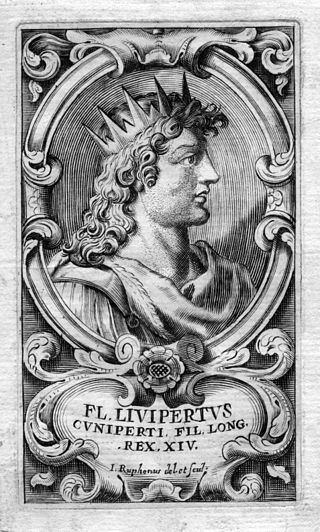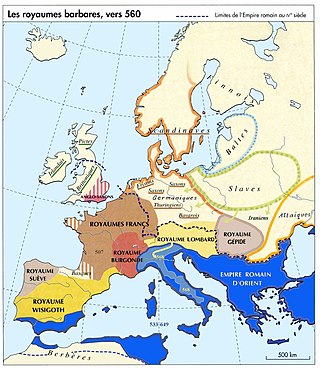
Alboin was king of the Lombards from about 560 until 572. During his reign the Lombards ended their migrations by settling in Italy, the northern part of which Alboin conquered between 569 and 572. He had a lasting effect on Italy and the Pannonian Basin; in the former, his invasion marked the beginning of centuries of Lombard rule, and in the latter, his defeat of the Gepids and his departure from Pannonia ended the dominance there of the Germanic peoples.

The Lombards or Longobards were a Germanic people who conquered most of the Italian Peninsula between 568 and 774.

Year 546 (DXLVI) was a common year starting on Monday of the Julian calendar. The denomination 546 for this year has been used since the early medieval period, when the Anno Domini calendar era became the prevalent method in Europe for naming years.

Chlothar III was King of the Franks, ruling in Neustria and Burgundy from 657 to his death. He also briefly ruled Austrasia.
Cleph was king of the Lombards from 572 to 574.
Arioald was the Lombard king of Italy from 626 to 636. Duke of Turin, he married the princess Gundeberga, daughter of King Agilulf and his queen Theodelinda. He was, unlike his father-in-law, an Arian who did not accept Catholicism.
Rodoald, was a Lombard king of Italy, who succeeded his father Rothari on the throne in 652. He was said to be lecherous and he was assassinated after a reign of just six months in 653 by the husband of one of his lovers. Paul the Deacon writes that Rodoald "had reigned five years and seven days, ", although historians note that this length of reign is suspect. Aripert, a rival claimant, was elected with the support of the Catholic Church, which opposed the Arian monarchy.

Liutpert was the Lombard king of Italy between 700 and 702, with interruption. Upon succeeding his father, King Cunincpert, at a young age, he ruled together with his tutor, Ansprand, the duke of Asti. After eight months, he was deposed by Raginpert, the duke of Turin and son of Godepert, Liutpert's great-uncle, but succeeded in returning to the throne several months later upon Raginpert's death, only to be deposed again, taken captive from Pavia, and drowned by Aripert II, Raginpert's son. He was buried in the Basilica of Santissimo Salvatore in Pavia.

Aripert I was king of the Lombards (653–661) in Italy. He was the son of Gundoald, Duke of Asti, who had crossed the Alps from Bavaria with his sister Theodelinda. As a relative of the Bavarian ducal house, his was called the Bavarian Dynasty.

Ansprand was king of the Lombards briefly in 712. Before that, he was the duke of Asti and regent during the minority of Liutpert (700–701). He was defeated at Novara by Raginpert and exiled during the subsequent war over the succession, fleeing to the court of Theudebert, duke of Bavaria, in 702.

Aripert II was the king of the Lombards from 701 to 712. Duke of Turin and son of King Raginpert, and thus a scion of the Bavarian Dynasty, he was associated with the throne as early as 700. He was removed by Liutpert, who reigned from 700 to 702, with the exception of the year 701, when Raginpert seized the throne. After his father's death, he tried to take the throne, too. He defeated Liutpert and the regent Ansprand's men at Pavia and captured the king, whom he later had strangled in his bath. He seized the capital and forced Ansprand over the Alps. He was firmly in power by 703.

Alduin was king of the Lombards from 547 to 560.
Raginpert was the Duke of Turin and then King of the Lombards briefly in 701. He was the son of Godepert and grandson of Aripert I. He usurped the throne in 701 and removed Liutpert, his grandnephew, putting his son Aripert in line for the succession. He and his Neustrians went out to meet the regent, Ansprand, in battle and defeated him at Novara, but died shortly after. His son Aripert did not succeed in taking the throne right away.
Garibald was the young son of Grimoald I of Benevento, king of the Lombards, and Theodota, daughter of Aripert I. After his father's death in 671, he reigned briefly for three months until the numerous adherents of Perctarit, his uncle, who had been exiled by Grimoald nine years earlier, besought their candidate to return and elected him, deposing the young king. He was the last Arian king in Europe.
The Lethings were a dynasty of Lombard kings ruling in the 5th and 6th centuries until 546. They were the first Lombard royal dynasty and represent the emergence of the Lombard rulership out of obscurity and into history.
The Gausi or Gausian dynasty was a prominent Lombard ruling clan in the second half of the 6th century (547–572). They were either pagans or perhaps Arian Christians and were frequently at odds with the Roman Catholic Church. Under their rule, the Lombards first migrated into the Italian peninsula.
Bisinus was the king of Thuringia in the 5th century AD or around 500. He is the earliest historically attested ruler of the Thuringians. Almost nothing more about him can be said with certainty, including whether all the variations on his name in the sources refer to one or two different persons. His name is given as Bysinus, Bessinus or Bissinus in Frankish sources, and as Pissa, Pisen, Fisud or Fisut in Lombard ones.
Rodelinda (6th-century), was a Lombard queen by marriage to king Audoin, and mother of king Alboin.
Thurisind was king of the Gepids, an East Germanic Gothic people, from c. 548 to 560. He was the penultimate Gepid king, and succeeded King Elemund by staging a coup d'état and forcing the king's son into exile. Thurisind's kingdom, known as Gepidia, was located in Central Europe and had its centre in Sirmium, a former Roman city on the Sava River.








